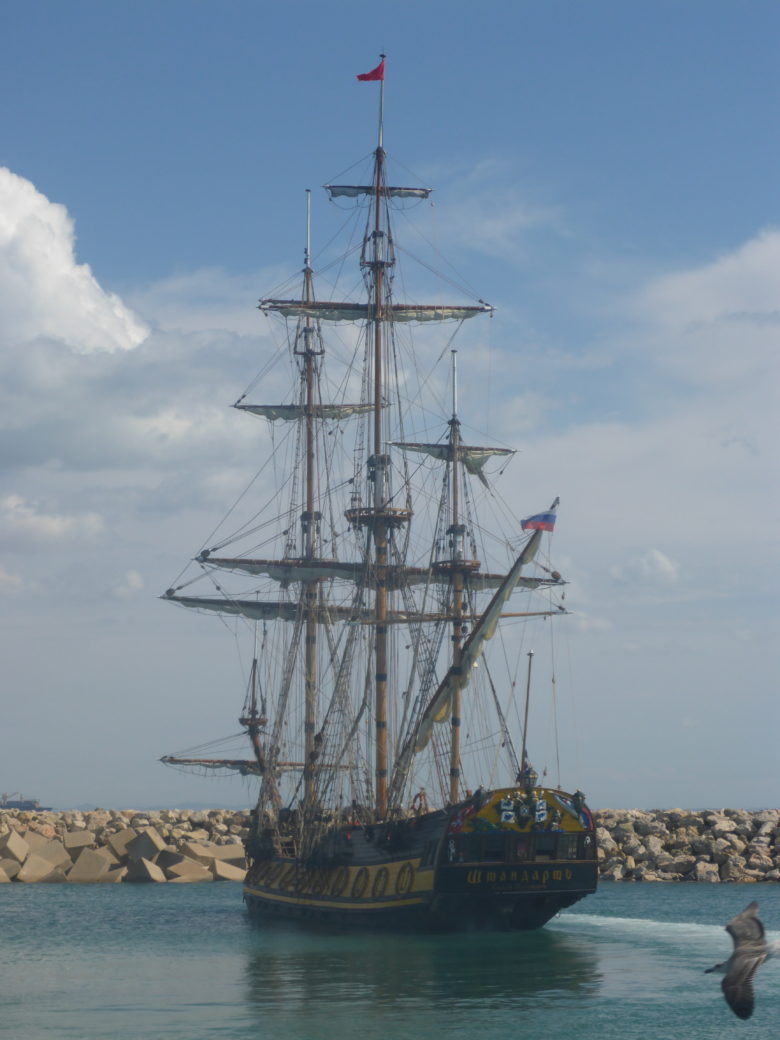Waxy winemakers and Wi-Fi Solutions
Rota Marina after Chipiona Departure
36:36.78N 6:20.76W
On our last evening in Chipiona we took a gentle stroll as the sun set, taking the intense heat with it leaving mellow warmth and light.
We were fascinated by the ingenious pre-roman fish corrals. They are stone walls, about a metre high that were built in ancient times and lead out from the shore over the flat sedimentary rock base, in not very regular shapes leading back to the shore forming fields or corrals. They are held together with goose barnacles, oyster shells and limpets forming a natural mortar. As the tide comes in to cover them it brings with it fish which breed and find shelter in their enclosed waters. As the tide ebbs through grills the fish are trapped. We watched the distant figures at work in their ‘fields’ of sea water.
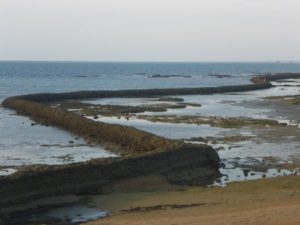
Each corral has a name; Hondo, Chico and Tres Piedras for example and one fisherman, the catador, is responsible for farming them in an eco-friendly, sustainable way. They catch stone bass, sea bass, pomfrets, cuttle fish, sea urchins, crabs and shrimps and this ancient way of fishing is unique to this area.
Chipiona has withstood the overbuilding of new apartment blocks mostly still unfinished, derelict and dilapidated with adjacent streets of pretty villas and some grand homes nestling amongst semi tropical plants and trees. The big church on the shore-side is painted sand colour and is well attended. A woman priest was talking from the pulpit as we peeped inside.
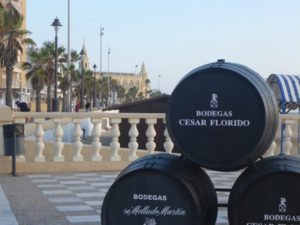
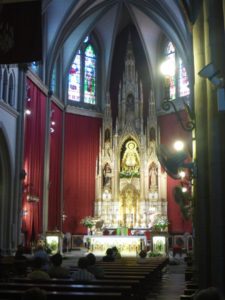
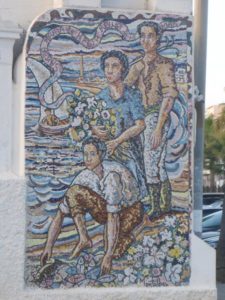
As if by accident we stumbled upon the Museum of Moscatel wine production with its sandstone floored courtyard area shaded by a vast dense vine covered gazebo. Small round metal tables of different heights were arranged throughout and wooden slated folding chairs were propped up against the walls. At the west end, through wrought iron gates, was a tiny vineyard with a modern built thatched cottage and an elderly couple made of wax sat near its door on their decking terrace. Beyond them the Chipiona lighthouse flashed its message over 25 miles out to sea.
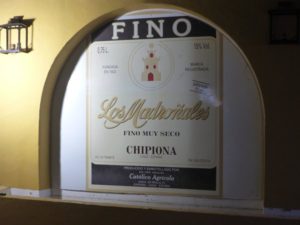
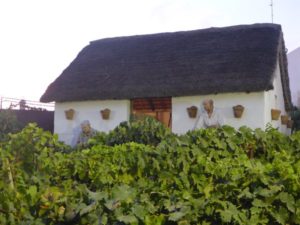
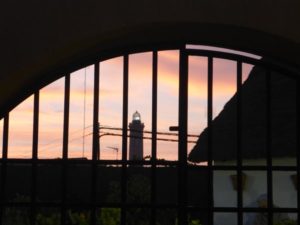
There were just a few folk there when we arrived, drinking the local world famous wine. I had white, just like Tio Pepe and Rob had the dry red sherry. They were really delicious and two full wine glasses cost less than two euros, about £1.00! We enjoyed the atmosphere as more people arrived, some having tapas and meeting friends of all ages. By the time we left all tables were taken and we later learned that we had probably missed the evening tour. There’s as good a reason as any to go back there one day.
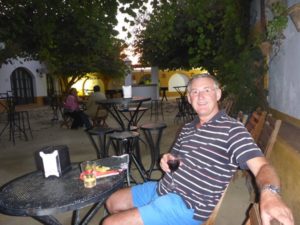
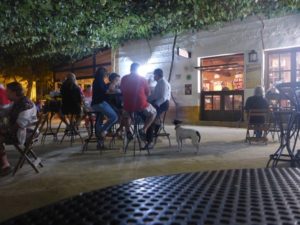
Rota Bound
Fuelled up we left the next morning passing the corrals and heading towards the Bajo Salmedina west cardinal pillar beacon, to the west of the dangerous rocky bank that stretches right in to the shore.
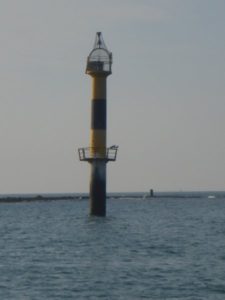
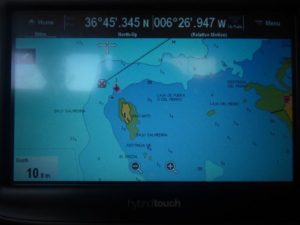
“Hey Barb I think that’s where the original HMS Pickle foundered a few years after the Battle of Trafalgar.” In 1808 in fact and on the chart the bank is marked with a wreck on it. If you remember the replica HMS Pickle was moored with us in Viana de Castillo. None of her crew was hurt, they probably just walked ashore. She was trying to steal an advantage on the Spanish at the time and at the enquiry that followed her demise the much valued Captain Cannadey was simply told not to let it happen again and he should be more careful in future.
A Wi-Fi Solution
Saturday 26th September. In Rota marina the marineira showed us where the free internet at the bibliotheca could be found. We made our way ashore and found the library closed until Monday. A young lad obviously knew the password as he sat in the shade of some trees close to the door and tapped away. You know what it is like when you want to get some things sorted out, you don’t want to wait for the convenience of others do you. All I can say, in case you have not already guessed dear readers, is that there are numerous advantages in having the ferry terminal to Cadiz located in the heart of your marina!
Cultural Cadiz
Since pre-Roman times Cadiz has been a major player in trade and culture with the Mediterranean, Europe and North Africa but in the 17th and 18th Centuries along with its sibling, Seville, they became two of the most important cities in the world, based on trade with the Americas.
The relatively new 18th to 19th Santa Iglesia Cathedral was financed by wealthy merchants and contains paintings and sculptures from centuries ago right up to date. Murillo of Seville, an advocate of modern naturalism, was well represented. Some sculptures were created by a woman and painted by her husband and another sculpture of a 21st century priest has only recently been completed and installed. History in the making.
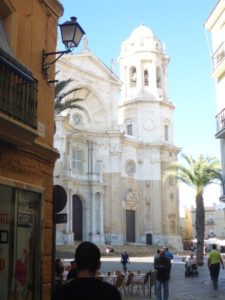
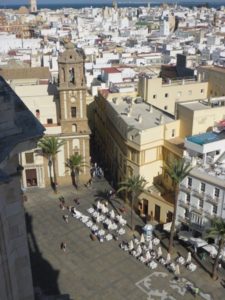
From the top of the cathedral views to the west reminded us that the watch towers, on top of the houses all over the city, have two purposes. First to keep an eye on who is coming into and leaving the harbour and secondly to spot ships returning from the Americas when they were 25 – 30 miles away.
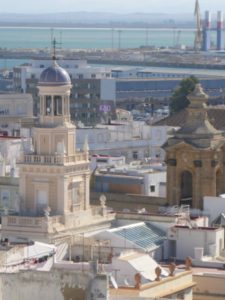
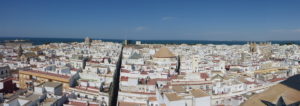
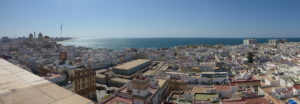
The connections with Seville were essential for the assimilation and distribution of the wealth being brought back from north, mid and south America. Tobacco came in through Cadiz, but because the air is too moist by the sea for the production of a commodity that relies on fire, it was shipped to the dryer, inland ‘Carmen’ factory in Seville for cigarette production.
When the Cadizians claim to be the source and origin of flamenco in the Santa Maria area, just like the Tiana area in Seville, it is likely it developed in both places at the same time as concepts and imaginations were shared between the two.
The city has been marked out with four different coloured walks each taking in areas differentiated by age, defences, Cadiz in its apogee and the 19th century Constitution written in 1812. We religiously followed the purple route and most of the green but then became side-tracked as we came across, for example, one of the biggest 1st century Roman amphitheatres on the Iberian Peninsula.
Fans flowers and fish.
In Flores Square full with sweet smelling flower stalls, a lovely place for lunch and some people watching, ‘guess who’s from the cruise liners’ became a favourite game. The food market was better on the Tuesday as the fish stalls were open with stunning displays of fruit de mer.
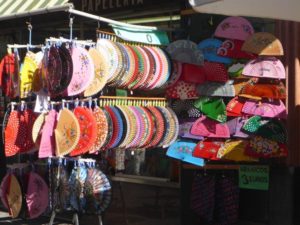
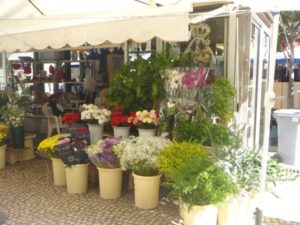
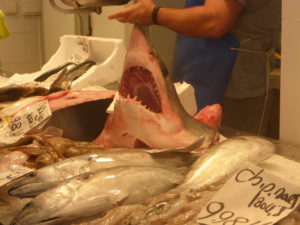
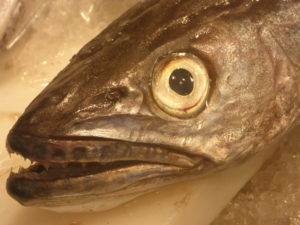
The camera obscura at the top of the Tavira watch tower revealed the city from a different angle as the lady guide provided a bridge made of folded paper suspended over the viewing dish for unaware pedestrians below to walk over and the new suspension road bridge, opened only a few days before, came into view in the distance.
We had a pretty intensive first day and flopped gratefully onto our seats on top of the ferry at 6.20 in the evening. On return we found the chunky Russian square rigger Shtandart, built between 1994 and 1999 and crewed by volunteer youngsters under a professional crew, moored in the marina. She is a replica of the original ship built in 1703 by Peter the Great to defend St Petersburg. We were impressed by her stoutness, orderly rig, boy and girl sailors at work in the rigging, aft accommodation where the crew sleep in hammocks and store their possession in wooden chests and the captain on his lap top in the galleried cabin below.
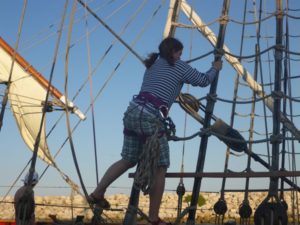
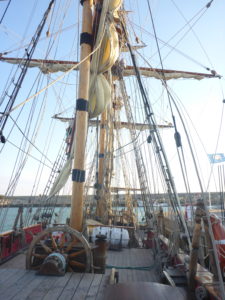
The young Russian crew were more interested in the plentiful oysters attached to the harbour wall. I could imagine that after the daylight had gone we might hear the chip chip of russian knives, and good luck to them. Free food, free Wi-Fi, no harm.
On the second day we followed our noses to Cadiz Museum, The Castle of Santa Catalina where there was an exhibition on the Flamenco artist known as Mariana of Cadiz, the lovely Delicias Gardens facing the Atlantic to the west and the San Felipe Auretorio, home of the 1812 Constitution.
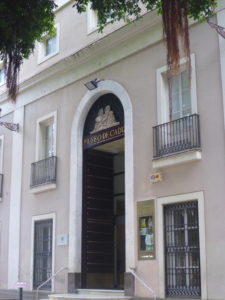
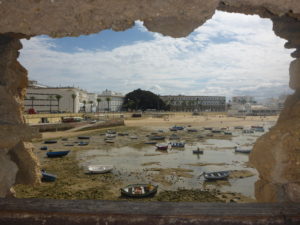
For the second time we were moved by the site of a young man making a living from selling the cuddly charms of a drugged Labrador puppy. To see street people accompanied by a canine friend is one thing, where but for good fortune go I, but to drug a very young attractive pup to make money was not right. We were ignorant visitors, who were we to take offence? Nevertheless I hoped and wondered if that pup would live long enough to run free and know it was loved.
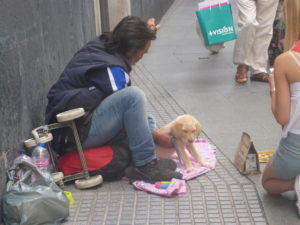
Apart from that we had two little loose ends to tie up. First I needed some red polyester thread to patch a hole in our small ensign and Rob needed some pot rivets to refix the aft hatch lid, both essential for our next leg and Cadiz being a place where people live, grow, work and play both purchases were easily made.
The Best Chiringuito around.
Before leaving on our next leg Rob and I decided to spend a couple of days relaxing on the beach. Equipped with rug, towels and brolly we pitched ourselves next to the stone pier near the marina. Lying peacefully we realised this had been a mistake as the smell meant the outfall from the pier was still in use. So the next day we walked along the beach to the vicinity of what looked like a really nice beach bar, The Azucar (sugar) of Cuba, complete with muslin drapes wafting elegantly in the breeze.
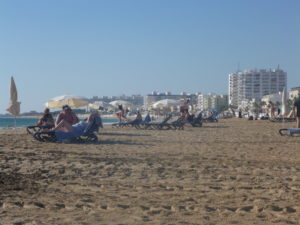
As you can imagine after a couple of sunbathing hours we were happily sitting at a corner table with four American Naval lads seated around a cable reel table enjoying their lunch next to us. When they had finished and left four more came to the table as if in a rota (!) system. They were all very friendly with the owner who was charming to us and proudly showed us the award with which he and his staff had been presented the day before, for The Best Chiringuito (beach bar) in the area, no doubt helped by the American patronage.
That evening we wandered ashore after dark to hear the clatter of horses’ hoofs on the cobbles and four very fine carriages being pulled by a pair of mules, a beautiful black Cobb and horse teams with their well-dressed drivers. We discovered they had just delivered 15 ‘brides’, beautiful young ladies of all shapes and sizes, wearing identical (except for size) full length cream- lace dresses, to the centre of town so they could be escorted by their ‘fathers’ in a long, slow moving procession to the ayuntamiento or town hall, in a castle like stone building around a cool, tiled courtyard.
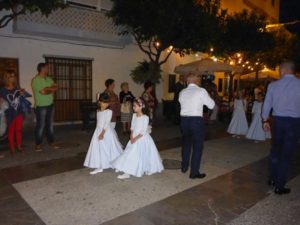
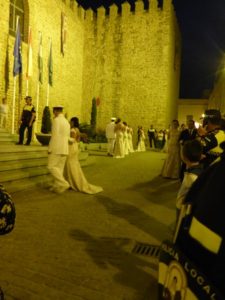
I wondered if this could be a mass wedding such as they have in Japan and China, but there were no grooms. There, behind closed doors, the queen was chosen and crowned and they all then made their way to the public square where they took their places on an elaborately decorated stage for speeches etc. Needless to say the townspeople were decked out in their best clothes to enjoy the spectacle. Two of the fathers were dressed in naval uniforms and I wondered if they were Spanish or Americans from the base. Rota certainly knows how to show itself to the world.

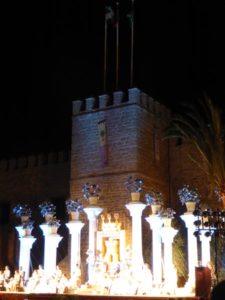
Interesting that there are protestors who want the Americans to leave, perhaps with America’s involvement in Syria the protestors feel it makes Rota a hot spot. All the while we were there the aircraft carrier, four warships and numerous helicopters were out on daily exercises. But I fear the town would decline in many ways if they leave.
The next day Bruce and Caroline from Flirtie, their Trident Voyager 40, came at 9.30 for a breakfast of scrambled eggs with smoked salmon and after hearing all about their trip to Seville, where they stayed in the Murillo as we recommended to them, they left at 1.00 and we made our way up to the supermarket for a final food shop.
The time to move on was upon us and we busied ourselves with preparations all day and went for a long walk as far as the American base before returning via a delightful Italian restaurant which was one of the few open on Sunday evening. Walking back down the pontoon to Zoonie I said, “Shall we take our Jamesons to Flirtie and see if they’d like a drink?”
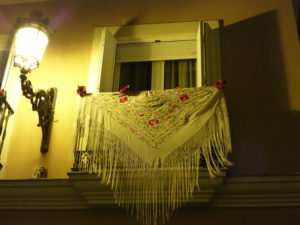
Well suffice it to say they had a very good selection of port after their visit to Porto so the evening concluded in an amicable haze.
Our muzzy heads the next morning were not our only reason for delaying the departure by one day. During the night the wind got itself into a frenzy and we could hear the waves crashing against the harbour wall. Dawn kind of appeared under a leaden sky but the day had no promise, so we spent it recovering and walking the other way around the town before a ‘dry’ evening!
